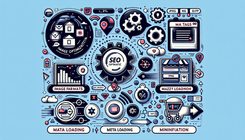What is a Good App to Use for SEO Image Optimizer?
Introduction
Image optimization is crucial for eCommerce websites. Optimizing images not only improves website speed but also enhances SEO, leading to better search engine rankings and user experience. This blog will discuss common issues and detailed solutions for optimizing images effectively on your Shopify store.
Common Issues in Image Optimization
Image Size
Large images can significantly slow down your website. Oftentimes, images are uploaded in their highest resolution without considering the impact on page load times.
Incorrect Formats
Using inappropriate image formats can also affect website speed. For example, JPEG is usually better for photographic images, while PNG is ideal for graphics with transparent backgrounds.
Meta Tags
Meta tags provide search engines with information about the image, but many people neglect to use them effectively. Missing or incorrect meta tags can hurt your SEO performance.
Lazy Loading
Not implementing lazy loading can mean that all images load at once, even if they're not immediately visible on the screen. This can drastically slow down page-load times.
Minification
Images often contain additional data that isn't required for display (EXIF data from cameras, for instance). Removing this data can reduce image sizes, thus speeding up load times.
Detailed Guide to Solving Image Optimization Issues
Step 1: Uploading Optimized Images
Before you upload an image, it's essential to resize it appropriately. Use tools like Photoshop or online services like TinyPNG to resize your images. This action alone can dramatically reduce load times.
Step 2: Choosing the Right Format
- JPEG: Best for photographs; balance quality and file size.
- PNG: Ideal for images requiring transparency.
- GIF: Suitable for small icons and animations.
- WebP: Modern format; best for reducing file size without losing quality.
Step 3: Implementing Meta Tags
Add descriptive ALT text and titles for all your images. This improves accessibility and SEO. Use keywords relevant to your content naturally.
Step 4: Using Lazy Loading
Lazy loading ensures that images load only when they are about to be displayed on the user's screen. This can be enabled through custom scripts or via built-in Shopify settings. Check the Shopify Documentation for guidance.
Step 5: Minification
Minify your images using various online tools, which remove unnecessary metadata. This helps in compressing the file size without losing quality.
Frequently Asked Questions (FAQ)
Q1: How can I track the performance of my image optimization?
Use tools like Google PageSpeed Insights to track the before-and-after performance of your site. This helps you understand the impact of your optimization efforts.
Q2: Do I need to know coding to implement these optimizations?
Basic understanding helps, but many tools and apps can assist you without any coding expertise. Shopify and BeMEApps provide user-friendly interfaces for optimizing images.
Q3: Can I revert the changes if something goes wrong?
Always keep a backup of your original images before making changes. Most optimization tools also provide options to restore original files.
Q4: How often should I optimize images on my site?
Regular updates and new content mean that image optimization should be an ongoing process. Review and optimize images at least quarterly to maintain speed and performance.
Conclusion
Image optimization is not a one-time task but an ongoing effort. By uploading optimized images, choosing the right formats, implementing meta tags, using lazy loading, and minifying images, you can significantly improve your site's speed and SEO. Leverage tools available within Shopify and BeMEApps to assist you in this continuous process. The key is to understand each feature, enable them gradually, and monitor your progress.
Need More Help?
If you encounter issues or need further guidance, don't hesitate to reach out to customer support or consult relevant user guides. There's also a wealth of online communities and forums where you can ask for help and share experiences.
By focusing on these elements, you can ensure your Shopify store runs smoothly, providing an optimized and swift user experience.




